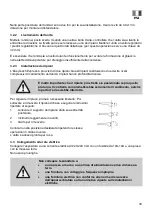
ENG
27
and improve the quality of the environment, protect human health and utilize natural resources
prudently and rationally. As an end-user, you are kindly requested to:
•
If the appliance has stopped working, even after troubleshooting; first see if it can be repaired,
before disposing it. Contact your distributor or supplier for further information on possible repairs
of your appliance, if in doubt.
•
If the appliance has reached its “End of Lifecycle” (EOL), in other words, the appliance is not
repairable or re-usable; do not dispose the appliance as an unsorted municipal waste. Instead,
call the relevant recycling company or the local Frigoglass Sales Office
to separately collect
the appliance for treatment and recycling.
Note:
The disposal of electronic and electrical appliances in landfill sites or through incineration
creates a number of environmental problems. When obsolete materials are not recycled, raw materials
have to be processed to make new products.
This represents a significant loss of resources; as the energy, transport and environmental damage
caused by these processes, is large.
Another problem is that these type of appliances may contain gases such as hydrofluorocarbons
(HFCs) used as the refrigeration coolant. HFCs are greenhouse gases which when emitted into the
atmosphere, contribute to climate change.
Fluorescent lighting from the appliance may contain potentially harmful substances such as toxic
heavy metals, in particular mercury, cadmium and lead. If they enter the body, these substances can
cause damage to the liver, kidneys and the brain.
Mercury is also a neurotoxin and has the potential to build up in the food chain.
•
To help in the recovery and recycling process of this appliance, do not dismantle or break parts
off the appliance, prior to collection. By removing parts off the appliance, you can reduce its
recyclability rate.
2.
The symbol shown in Fig. 1 below, which is also on the Product Label inside the appliance,
indicates for separate collection of electrical and electronic equipment; based on the European
Community (EC) WEEE Directives.
Figure 1
- Crossed-Out Wheeled Bin
Note:
If your appliance has this symbol placed on it, your responsibility as an end-user and
contribution to recycling, is to ensure that the appliance is not thrown away with unsorted municipal
waste,
but is collected separately from a recycling company.
Please contact the relevant recycling company or the local Frigoglass Sales Office
for further
information regarding collection arrangements.
3.
Finally, observe any recycling laws applicable to your community or country.































![FRIGOGLASS Retro [R290] LC User Manual preview](http://thumbs.mh-extra.com/thumbs/frigoglass/retro-r290-lc/retro-r290-lc_user-manual_2338098-001.webp)










